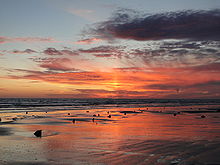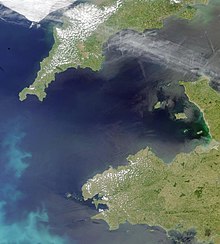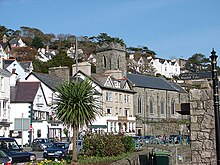Cantre'r Gwaelod

Cantre'r Gwaelod (also: Irish Cantref Gwaelod , Cantref y Gwaelod , English The Lowland Hundred dt .: " The Lowland Hundred ") is a legendary ancient sunken kingdom, which is in the fertile land between Ramsey Island and Bardsey Island in today's Cardigan Bay is said to have been located in west Wales . It is known as "Welsh Atlantis " (Welsh Atlantis) and plays a role in folklore, literature and songs.
Legend
Cantre'r Gwaelod was an area west of Wales that is now believed to be submerged in the Cardigan Bay area. Legends say the land stretched south from Bardsey Island to Cardigan or even Ramsey Island and up to 20 miles west of the present-day coastline.
There are several versions of the legend. The oldest is found in the Black Book of Carmarthen , in which the land is referred to as Maes Gwyddno ( Gwyddno Plain). In this version, the land was lost when a well-maiden (spring nymph) named Mererid neglected her duties and overran her spring, whereupon the land was flooded.
Rachel Bromwich , however, doubts this assignment. She relates Gwyddno Garanhir to Hen Ogledd , not Wales.
The version common today probably dates from the 17th century. In this version Cantre'r Gwaelod is described as lowland raised against the sea by a dike was attached Sarn Badrig ( " Saint Patrick dam"), with a number of shooters (sluice gates) that were opened during low tide around the country to drain.
The main town was called Caer Wyddno and was the seat of Gwyddno Garanhir . Two princes of the area were responsible for the dike. One of them, a certain Seithenyn , is described as a drinker and a womanizer . His neglect of duty allowed the sea to penetrate through the flood gates that were left open and destroy the land.
It is said that the church bells of Cantre'r Gwaelod rang in times of danger.
Relationship to the myth of Llys Helig
Bromwich refers to a similar legend, about the kingdom of Helig ap Glanawg in the Conwy estuary . As with Cantre'r Gwaelod, there are reports of sightings of the remains of the sunken kingdom of Llys Helig . Bromwich believes the two stories influenced each other. The Halliwell manuscript also uses the title "Lord of Cantre'r Gwaelod" for Helig. In New Directions In Celtic Studies , Antone Minard writes that the two legends cite the same evidence (bells, sunken ruins).
Origins of the legend
The legend could be traced back to lore about rising sea levels after the end of the last ice age. The remains of the sunken forests of Borth and the landscape of the Sarn Badrig could have been taken as evidence of tragedy and the legend developed from these elements.
Relationship with other legends
The legend of Cantre'r Gwaelod is comparable to the Flood stories in many other ancient cultures and has also been related to the story of Atlantis . Several similar legends exist in Celtic mythology . Examples of this are the Breton legend of Ker-Ys and the legend from the Arthurian circle of Lyonesse or the other world Tír na nÓg . It's always about sunken countries in the Celtic Sea , off the coast of Brittany or Cornwall . (See also: The Schimmelreiter .)
archeology
There is no solid evidence of previous settlement or principality in the marine areas that are named, although some sightings are reported.
In 1770, Welsh antiquarian William Owen Pughe wrote about sunken human settlement four miles off the coast of Ceredigion , between the Ystwyth and Teifi rivers .
In the 1846 edition of The Topographical Dictionary of Wales , Samuel Lewis describes the remains of stone walls and roads beneath the shallow waters of Cardigan Bay:
“In the sea about seven miles west of Aberystwyth in Cardiganshire lies a collection of loose stones called Caer Wyddno,“ the fortified palace of Gwyddno ”; and subsequently are the remains of one of the southern streets or dams of Catrev Gwaelod. The depth of the water over the whole of the Bay of Cardigan is not great; and when the tides retreated, stones with Latin inscriptions and Roman coins by various emperors were found under the deepest waterline: in various places in the water, as well, there are trees that have been turned over. "
Lewis believes that the Cardigan Bay coastline runs in the same places in the maps of the ancient cartographer Ptolemy as it was in his time and believes that the flood occurred before the second century AD.
The causeways that Lewis describes can now be seen on the beaches around Cardigan Bay. The so-called Sarnau are banks that extend several miles into the sea at right angles to the coast. They lie between the four estuaries to the north of Cardigan Bay. Geologists suspect that these clay, gravel, and rock formations are ancient moraines that formed during the retreat of the glaciers at the end of the last Ice Age. In 2006 an episode of the BBC's documentary series Coast showed Sarn Gynfelyn at Wallog and the remains of the lost forest at Ynyslas (Borth), which are also associated with Cantre'r Gwaelod. There are remains of oak , pine , birch , willow and hazelnut trees , which have been preserved due to the acidic, anaerobic conditions in the tidal flats and which come to the fore at low tide. They are estimated to be 5000 years.
gallery
Inclusion in culture
literature
The legend has inspired numerous poems and songs through the centuries. The earliest mention of Cantre'r Gwaelod is a reference from the 13th century in the Black Book of Carmarthen ; in a poem " Boddi Maes Gwyddno " ("The Fall of the Land of Gwyddno") the fairy tale of Mererid and the spring is told.
The story influenced a Victorian-era novel , The Misfortunes of Elphin by Thomas Love Peacock (1829). At the National Eisteddfod of Wales in Pwllheli in 1925 , Dewi Morgan ('Dewi Teifi') won the Chairing of the Bard (Bardic Chair) with his Awdl ( rhyming poem) of this legend based on Peacock's version.
The geologist William Ashton discusses the legend in his book The Evolution of a Coast-Line, Barrow to Aberystwyth and the Isle of Man, with Notes on Lost Towns, Submarine Discoveries, & C from 1920 and draws as evidence of a lost land in the Cardigan Bay Ptolemy's map. Ashton also drew a map of Cantre'r Gwaelod himself in the bay.
Cantre'r Gwaelod also appears in modern children's books. For example, in the award-winning book A String in the Harp by Nancy Bond (1977 Newbery Medal ). In Silver on the Tree , the final book in The Dark Is Rising series by Susan Cooper , the kingdom plays a role; Parts of the action take place in Aberdyfi . Siân Lewis 'and Jackie Morriss' book Cities in the Sea (2002) tells the legend for children, and the Welsh musician Cerys Matthews brings the story The Ghost Bells of the Lowlands in his book Tales from the Deep (2011) .
Music and art
The folk song "Clychau Aberdyfi" (" The Bells of Aberdovey "), popular in the 18th century, refers to the part of the legend where the bells are heard in the waves near Aberdyfi . This song inspired two art projects in the city: a new bell was placed in the tower of St Peter's Church Aberdyfi in September 1936 , which can play the song The Bells of Aberdovey . An art installation by Marcus Vergette , a bronze “Time and Tide Bell”, was installed in 2011 on the jetty in Aberdyfi Harbor. The bell is struck by the movement of the water at high tide.
The legend of children is re-enacted in the BBC production Telly Tales by CBeebies 2009.
Web links
- Cantre'r Gwaelod - The Lost Land of Wales
- Experts look for 'watery kingdom'
- An exploration of the 'walled realm' version of the myth, and the semi-legendary King Gwyddno
- local history page looking at possible documentary evidence
- Submerged forest, Borth Sands, Wattle walkway exposed by storms of January 2014 - from the Royal Commission on the Ancient and Historical Monuments of Wales
Individual evidence
- ↑ Robin Gwyndaf: 34. Cantre'r Gwaelod, Dyfed . In: Welsh folk tales / Chwedlau gwerin Cymru , 2nd edition, National Museum Wales / Amgueddfa Genedlaethol Cymru, Cardiff 1989, ISBN 978-0-7200-0326-0 .
- ↑ a b c Cantre'r Gwaelod - The Lost Land of Wales . In: Legacies - UK History Local to You . BBC. Retrieved January 4, 2012.
- ^ "There is no certainty, however, that in twelfth century tradition Maes Gwyddneu did represent the submerged land in Cardigan Bay."
- ↑ Rachel Bromwich: Cantre'r Gwaelod and Ker-Is . In: Cyril Fox, Bruce Dickins (Eds.): The Early Cultures of North-West Europe . Cambridge University Press, 1950, p. 231.
- ↑ "The widespread parallels to this inundation theme would suggest that the two stories are in fact one in origin, and were localized separately in Cardiganshire and in the Conway estuary, around two traditional figures of the sixth century." Rachel Bromwich: Cantre'r Gwaelod and Ker-Is . In: Cyril Fox, Bruce Dickins (Eds.): The Early Cultures of North-West Europe . Cambridge University Press, 1950, p. 231.
- ↑ "The Welsh legends of Cantre'r Gwaelod and Llys Helig (Helig's Court) contain the same details of audible bells beneath the waves and ruins which are visible at the equinoctial tides, which are the anchors of credulity in the story." Antone Minard : Pre-Packaged Breton Folk Narrative . In: Amy Hale and Philip Payton (Eds.): New Directions In Celtic Studies . University of Exeter Press, 2000, ISBN 9780859896221 , p. 60.
- ↑ a b 5. Submerged Forest . In: Mid Wales Coast - Ynyslas Walk . BBC. Retrieved January 4, 2012.
- ^ Brian Haughton: Haunted spaces, sacred places: a field guide to stone circles, crop circles, ancient tombs, and supernatural landscapes . New Page Books, Franklin Lakes, NJ 2008, ISBN 1-60163-000-X , p. 100.
- ↑ In the sea, about seven miles west of Aberystwyth in Cardiganshire, is a collection of loose stones, termed Caer Wyddno, "the fort or palace of Gwyddno;" and adjoining it are vestiges of one of the more southern causeways or embankments of Catrev Gwaelod. The depth of water over the whole extent of the bay of Cardigan is not great; and on the recess of the tide, stones bearing Latin inscriptions, and Roman coins of various emperors, have been found below high-water mark: in different places in the water, also, are observed prostrate trees. Samuel Lewis : The Topographical Dictionary of Wales.
- ^ Thomas Love Thomas Love Peacock: 1. The Prosperity of Gwaelod . In: The Misfortunes of Elphin . Thomas Hookham, 1829, p. 240.
- ^ William Ashton: 31. The Lost Cantref Gwaelod . In: The Evolution of a Coast-Line, Barrow to Aberystwyth and the Isle of Man, with Notes on Lost Towns, Submarine Discoveries, & C . Edward Stanford Ltd, London, ISBN 978-1-176-60264-9 . ( map illustration on page 257 )
- ^ Siân Lewis & Jackie Morris: Cities in the sea . Pont, Llandysul 2002, ISBN 1-84323-172-7 .
- ↑ Cerys Matthews writes children's book of Welsh legends . In: BBC News , May 4, 2011. Retrieved January 4, 2012.
- ↑ New bell rings as the tide rises in Aberdyfi, Gwynedd. In: BBC News July 12, 2011.
- ^ Time and Tide Bell . In: Marcus Vergette official website . Retrieved January 3, 2012.








